Night sky, October 2024: What you can see tonight [maps]
Find out what's up in your night sky during October 2024 and how to see it in this Space.com stargazing guide.
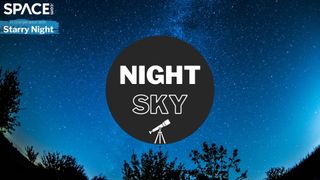
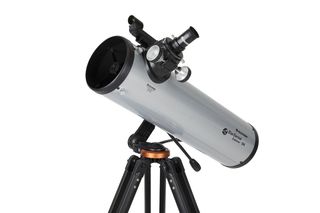
Looking for a telescope for the next night sky event? We recommend the Celestron StarSense Explorer DX 130AZ as the top pick for basic astrophotography in our best beginner's telescope guide.
The night sky tonight and on any clear night offers an ever-changing display of fascinating objects you can see, from stars and constellations to bright planets, the moon, and sometimes special events like meteor showers.
Observing the night sky can be done with no special equipment, although a sky map can be very useful, and a good telescope or binoculars will enhance some experiences and bring some otherwise invisible objects into view. You can also use astronomy accessories to make your observing easier, and use our Satellite Tracker page powered by N2YO.comto find out when and how to see the International Space Station and other satellites. We also have a helpful guide on how you can see and track a Starlink satellite train.
You can also capture the night sky by using any of the best cameras for astrophotography, along with a selection of the best lenses for astrophotography.
Read on to find out what's up in the night sky tonight (planets visible now, moon phases, observing highlights this month) plus other resources (skywatching terms, night sky observing tips and further reading)
Related: The brightest planets in September's night sky: How to see them (and when)
Monthly skywatching information is provided to Space.com by Chris Vaughan of Starry Night Education, the leader in space science curriculum solutions. Follow Starry Night on Twitter @StarryNightEdu and Chris at @Astrogeoguy
Editor's note: If you have an amazing skywatching photo and would like to share them with Space.com's readers, send your photo(s), comments, and your name and location to spacephotos@space.com.
Calendar of observing highlights
Tuesday, Oct. 1 - Comet Tsuchinshan-ATLAS and morning zodiacal light (pre-dawn)
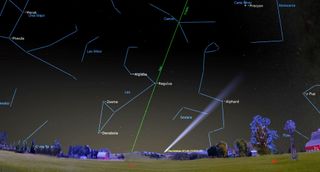
During autumn at mid-northern latitudes every year, the ecliptic extends nearly vertically upward from the eastern horizon before dawn. That geometry favors the appearance of the faint zodiacal light in the eastern sky for about half an hour before dawn on moonless mornings. Zodiacal light is sunlight scattered by interplanetary particles that are concentrated in the plane of the solar system — the same material that produces meteor showers. The phenomenon is more readily seen in areas free of urban light pollution. Between now and the full moon on Oct. 17, look for a broad wedge of faint light extending upwards from the eastern horizon and centered on the ecliptic (the green line). It will be strongest in the lower third of the sky around the bright star Regulus in Leo. If Comet C/2023 A3 (Tsuchinshan-ATLAS) becomes as bright as hoped, it may also be visible before dawn in early Oct. Don't confuse the zodiacal light with the Milky Way, which is positioned nearby in the southeastern sky.
Wednesday, Oct. 2 - New Moon and Annular Solar Eclipse
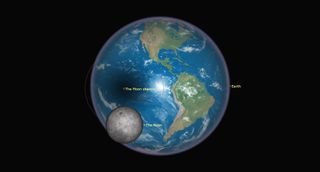
When the new moon passes the sun on Wednesday, Oct. 2 at 2:49 p.m. EDT, 11:49 a.m. PDT, or 18:49 GMT, it will generate an annular solar eclipse visible in the eastern and southern Pacific Ocean region. Since the moon will reach apogee only an hour after that, it will be farther from the Earth and too small to completely block the sun's disk, resulting in an annular, or "ring of fire", solar eclipse. The narrow track where annularity will be visible will begin about 1,000 miles (1,700 km) south of the Hawaiian Islands at 16:54 GMT or 7:54 a.m. Hawaiian time. From there, the moon's shadow will sweep southeast across the ocean, reaching greatest eclipse, with 7.4 minutes of annularity, at 18:45 GMT, and then 6.4 minutes of annularity on Rapa Nui (Easter Island) at 2:07 p.m. EASST or 19:07 GMT. The eclipse will reach the mountainous Patagonian coast of Chile at or 5:22 p.m. CLST or 20:22 GMT, then the eastern coast of Argentina six minutes later at 20:28 GMT. The eclipse will end 340 miles (550 km) north of South Georgia Island at 20:36 GMT. A broad region surrounding the annularity track will see a partial solar eclipse. Exact times for your location can be obtained from astronomy apps like Starry Night and SkySafari. Proper protective solar filters will be required to view any part of this solar eclipse.
Saturday, Oct. 5 - Young moon near Venus (after sunset)
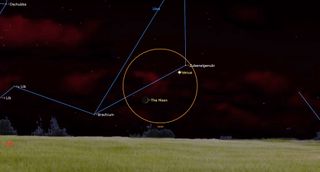
In the southwestern sky for a short period after sunset on Saturday, Oct. 5, the slender crescent of the young moon will shine several finger-widths to the lower left (or celestial south) of the very bright planet Venus. The duo will be cozy enough to share the view in binoculars (orange circle), but wait until the sun has completely set before using them. On Sunday evening, the moon's eastward orbital motion will place it more than a fist's diameter to Venus' left, and a little higher, making it easier to see. Venus is farther from Earth than the sun, so it will show a gibbous phase in a telescope, in contrast to the crescent moon.
Sunday, Oct. 6 - Earthshine (after sunset)
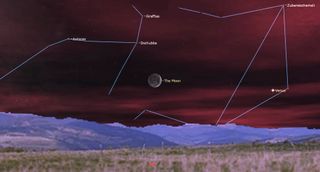
On the evenings surrounding Sunday, Oct. 6, the young crescent moon will shine low in a twilit southwestern sky after sunset. Watch for Earthshine, also known as the Ashen Glow and "the old moon in the new moon's arms". That's sunlight reflected off Earth and back onto the moon, slightly brightening the dark portion of the moon's Earth-facing hemisphere. The phenomenon appears for several days before and after each new moon. Since the Earthshine light has made an extra round trip from Earth to the moon and back, it is about 2.6 seconds "older" than than the light we see from the lit crescent.
Monday, Oct. 7 - Crescent moon meets Antares (evening)
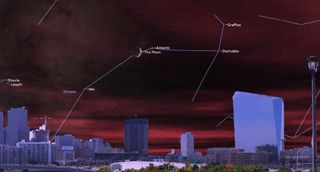
As the sky begins to darken after sunset on Monday, Oct. 7, Scorpius' brightest star Antares, the "rival of Mars", will twinkle a short distance to the right (or celestial northwest) of the young crescent moon. In the Eastern Time zone, the reddish star will be positioned about two finger widths from the moon. Skywatchers viewing the scene in more westerly zones will see the moon farther from the star. Hours earlier, residents of the Galapagos Islands and west across the South Atlantic Ocean to Easter Island are able to watch the moon occult Antares. For those living in the southern half of South America, the occultation occurs in a bright sky.
Wednesday, Oct. 9 - Jupiter reverses course (late night)
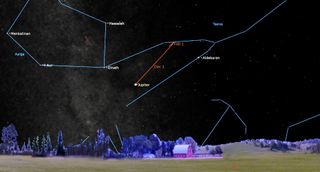
On Wednesday, Oct. 9, the eastward prograde motion of the planet Jupiter between the horns stars of Taurus will slow to a stop. After tonight, Jupiter will accelerate into a westward retrograde loop that will last until early February (red path). The planet's bright, white dot will be shining in the lower part of the eastern sky in late evening and then high in the west at sunrise. Retrograde loops occur when Earth, on a faster orbit closer to the sun, passes distant planets "on the inside track", making them appear to move backward across the stars for a period of time. You can notice Jupiter's motion over the coming weeks by comparing its position to the bright stars Elnath and Aldebaran to its upper left and upper right, respectively.
Thursday, Oct. 10 - First Quarter Moon
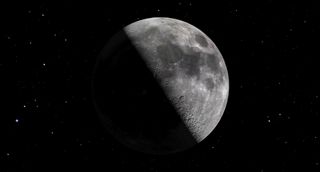
The moon will complete the first quarter of its journey around Earth on Thursday, Oct. 10 at 2:55 p.m. EDT or 11:55 a.m. PDT, which converts to 18:55 GMT. At first quarter, the moon's 90-degree angle from the sun will cause us to see it half-illuminated — on its eastern side, and shining to the left (celestial east) of the Teapot-shaped stars of Sagittarius after dusk. At first quarter, the moon always rises around mid-day and sets around midnight, so it is also visible in the afternoon daytime sky, too. The evenings surrounding first quarter are the best ones for seeing the lunar terrain when it is dramatically lit by low-angled sunlight, especially along the terminator, the pole-to-pole boundary that separates the lit and dark hemispheres.
Saturday, Oct. 12 - Mare Imbrium's Golden Handle (all night)
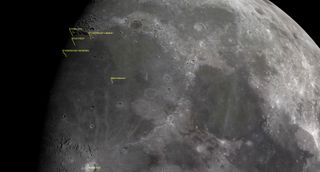
On Saturday night, Oct. 12, the terminator on the waxing gibbous moon will cross Sinus Iridum, the Bay of Rainbows. The circular 155 mile (249 km) diameter feature is a large impact crater that was flooded by the same basalts that filled the much larger Mare Imbrium to its east — forming a rounded "handle" on the western edge of that mare. The "Golden Handle" effect is produced when sunlight strikes the prominent Montes Jura mountain range surrounding Sinus Iridum on the north and west while the floor of the bay remains dark. Sinus Iridum is almost craterless, but hosts a set of northeast-oriented wrinkle ridges that are revealed around this phase.
Sunday, Oct. 13 - Moon approaches Saturn (overnight)
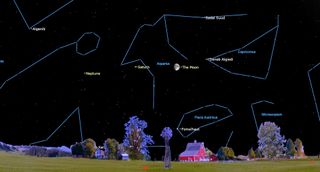
As the sky darkens on Sunday evening, Oct. 13, the prominent, yellowish dot of Saturn will appear shining about a fist's diameter to the left (or 10 degrees to the celestial northeast) of the bright, waxing gibbous moon. Skywatchers viewing the duo later, in more westerly time zones, or above the southwestern horizon before dawn on Monday, will see the moon closer to Saturn. On Monday evening around 1 a.m. EDT (0500 GMT) observers located along a zone extending from southern Africa east across Madagascar, the southeastern Arabian Peninsula, and most of southern Asia, China, and Mongolia can watch the moon occult Saturn.
Monday, Oct. 14 - Gibbous moon near Saturn (all night)
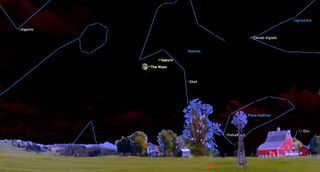
After another 24 hours of easterly orbital motion, the bright gibbous moon will move to shine several finger widths to the left of Saturn all night long on Monday, Oct. 14. During the night, the moon will move farther from Saturn and the diurnal rotation of the sky will lift the moon above the ringed planet before they set a few hours before dawn.
Monday, Oct. 14 - Medusa's eye pulses (at 8:46 p.m. EDT)
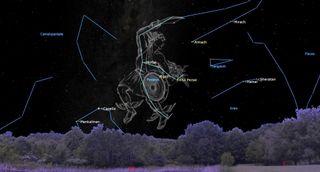
In the constellation of Perseus, Algol, also designated Beta Persei, marks the glowing eye of Medusa from Greek mythology. The star is among the most accessible variable stars for skywatchers. During a ten-hour period that repeats every 2 days, 20 hours, and 49 minutes, Algol dims noticeably and re-brightens by about a third. This happens when a fainter companion star with an orbit nearly edge-on to Earth crosses in front of its much brighter primary, reducing the total light output we perceive. Algol normally shines at magnitude 2.1, similar to the nearby star Almach (aka Gamma Andromedae). But when fully dimmed, Algol's brightness of magnitude 3.4 is almost identical to Rho Persei (or Gorgonea Tertia or ρ Per), the star sitting just two finger widths to Algol's lower right (or 2.25 degrees to the celestial south). On Monday evening, Oct. 14 at 8:46 p.m. EDT (0046 GMT on Oct. 15), Algol will be at its minimum brightness in the lower part of the northeastern sky. Five hours later the star will return to full intensity from a perch nearly overhead.
Tuesday, Oct. 15 - Grimaldi graces the edge (all night)
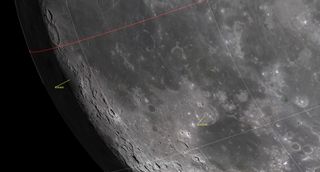
The dark-floored basin named Grimaldi is a prominent foreshortened oval located near the western edge of the moon. It is just south of the moon's equator (the up-down red curve) and below, or lunar southwest of, the large, dark patch of Oceanus Procellarum, the Sea of Storms. The 108 mile (175 km) diameter basin is easy to see using your unaided eyes and through binoculars and telescopes. On Tuesday, Oct. 15 the terminator on the waxing gibbous moon will fall just to the west of the crater, accentuating its complex, pitted rim and some subtle wrinkle ridges on the basalts of its eastern floor. The 14 mile (22 km) wide fresh crater named Grimaldi B on the basin's northern edge is visible under magnification. Grimaldi will be fully illuminated from Wednesday night onward.
Thursday, Oct. 17 - Full Hunter Supermoon
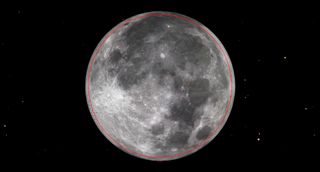
The full moon of October will occur at 7:26 a.m. EDT, 4:26 a.m. PDT, or 11:26 GMT, on Thursday, Oct. 17. In the Americas the moon will look full on both Wednesday night and Thursday night, but magnified views will reveal a slim rind of shadow along its right and left rim, respectively, from one night to the next. This full moon is traditionally called the Hunter's Moon, Blood Moon, or Sanguine Moon. The Anishinaabe people of the Great Lakes region call it Binaakwe-giizis, the Falling Leaves Moon, or Mshkawji-giizis, the Freezing Moon. The Cree Nation of central Canada calls it Opimuhumowipesim, the Migrating Moon — the month when birds are migrating. The Haudenosaunee (Iroquois / Mohawk) of Eastern North America use Kentenha, the Time of Poverty Moon. Full moons in October always shine in or near the stars of Cetus and Pisces. With the moon passing perigee only 10.5 hours prior, this full moon will also be the third and largest of four consecutive supermoons in 2024. It will appear about 6% larger and 16% brighter than an average full moon (shown by the red circle), cross the sky from sunset to sunrise, and will produce large tides around the world.
Saturday, Oct. 19 - Bright moon near the Pleiades (overnight)
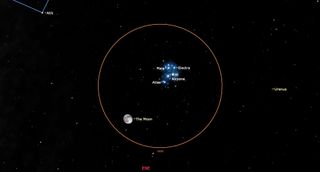
On Saturday night, Oct. 19, the bright little Pleiades star cluster, also known as Messier 45, the Seven Sisters, the Hole in the Sky, and Matariki will be positioned several finger widths to the upper right (or celestial west) of the bright, waning gibbous moon. While the cluster's stars will be hard to see against the moon's glare, hiding the moon beyond the lower left edge of binoculars (orange circle) will reveal them. The cluster is a highlight of the autumn/winter sky.
Sunday, Oct. 20 - Bright moon and Jupiter in the Winter Hexagon (wee hours to dawn)
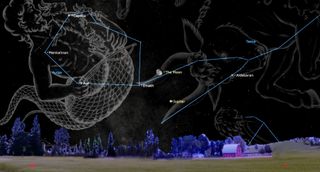
Around mid-evening on Sunday, Oct. 20, the bright, waning gibbous moon will rise in the east with brilliant Jupiter shining a palm's width to its lower right (or 6 degrees to its celestial southwest). The prominent star Elnath, which marks the northern horn tip of Taurus, the Bull, will sparkle just to the lower left of the moon. The trio will shift into the southwestern sky by dawn. By then the moon will shine extremely close to Elnath. If you head outside between the wee hours and dawn, the bright ring of stars forming the gigantic Winter Hexagon asterism will surround Jupiter and the moon. Jupiter will spend the coming year wandering inside the hexagon, while the moon will pass through it monthly.
Saturday, Oct. 21 - Orionid Meteor Shower peak (pre-dawn)
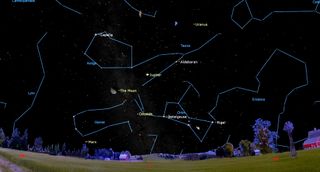
The annual Orionid meteor shower is produced when the Earth passes through a cloud of small particles dropped by repeated passages of Comet Halley along its orbit. Viewed in a dark sky during the peak of the shower, 10 to 20 bright and fast-moving meteors are usually seen each hour. Although the Orionids is active from September 26 to November 22, it will peak in the Americas on the evening of Monday, Oct. 21, when Earth will be crossing the densest region of the particle field. Start watching for Orionids after dusk on Monday night, before the bright gibbous moon clears the rooftops at around 10 p.m. Orionids meteors will appear anywhere in the sky, but they can be traced back to their radiant in the constellation of Orion. Unfortunately that bright moon will shine near the radiant all night long.
Tuesday, Oct. 22 - Moon meets Castor, Pollux and Mars (overnight)
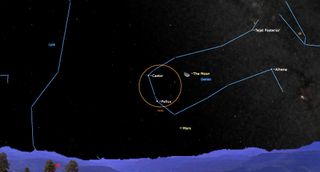
When the waning half-moon clears the rooftops in the eastern sky at around 11 p.m. local time on Tuesday, Oct. 22, it will be forming a pretty triangle to the right (or celestial southwest) of the up-down pair of bright stars of Gemini, Castor and Pollux. During the night, the moon's easterly orbital motion will carry it closer to Pollux, the lower, more easterly star, allowing all three objects to share the view in binoculars (orange circle) by dawn. The bright red planet Mars will appear below the trio after it, too, rises high enough after midnight.
Thursday, Oct. 24 - Third Quarter Moon

The moon will complete three quarters of its orbit around Earth, measured from the previous new moon, on Thursday, Oct. 24 at 4:03 a.m. EDT, 1:03 a.m. PDT, or 08:03 GMT. At the third (or last) quarter phase the moon appears half-illuminated, on its western, sunward side. It will rise around midnight local time, and then remain visible until it sets in the western daytime sky in early afternoon. Third quarter moons are positioned ahead of the Earth in our trip around the sun. About 3½ hours later, Earth will occupy that same location in space. The week of dark, moonless evening skies that follow this phase are the best ones for observing fainter deep sky targets.
Friday, Oct. 25 - The Andromeda Galaxy (all night)
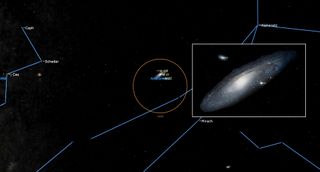
In late October, the Andromeda Galaxy is climbing the eastern sky during evening. This large spiral galaxy, also designated Messier 31 and NGC 224, is 2.5 million light years from us, and covers an area of sky measuring 3 by 1 degrees (or six by two full moon diameters)! Under dark skies, M31 can be seen with unaided eyes as a faint smudge located 1.4 fist diameters to the left (or 14 degrees to the celestial northeast) of Alpheratz, the star that forms the left-hand (northwestern) corner of the square of Pegasus. The three westernmost stars of Cassiopeia, Caph, Shedar, and Navi (Gamma Cas), also conveniently form an arrow that points towards M31. Binoculars will reveal the galaxy better. In a telescope, use low magnification and look for M31's two smaller companion galaxies, the foreground Messier 32 and more distant Messier 110 (inset).
Monday, Oct. 28 - The dolphin swims the southern sky (all night)
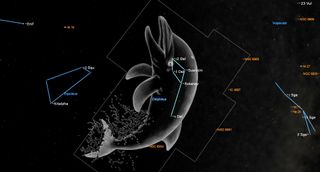
During mid-evening in late October, the small constellation of Delphinus is positioned high in the southern sky. Look for its five 4th magnitude stars shining just to the lower left (or celestial southeast) of the line connecting the very bright stars Deneb and Altair. According to Greek legend, Poseidon, god of the seas, was assisted in a matter of the heart by a friendly dolphin, so he rewarded it with a place of honor in the heavens. Delphinus' brightest two stars are bluish Sualocin, at the top of its head, and whitish Rotanev, at the nape of its neck. Those funny appellations are actually the name of 19th century astronomer Nicolaus Venator spelled backwards. Gamma Delphinus, the star marking the dolphin's nose, is a close-together double star with one component a greenish colour. Despite swimming close to the Milky Way, Delphinus' only prominent deep sky objects are two globular clusters designated NGC 7006 and NGC 6934, which are also numbers C42 and C47, respectively on Sir Patrick Moore's Caldwell List.
Tuesday, Oct. 31 - The spooky Owl Cluster (all night)
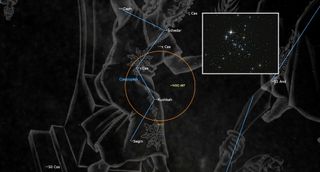
One of my favorite spooky objects can be seen in binoculars or a backyard telescope on autumn evenings. It's one of the many bright, open star clusters in the W-shaped of Cassiopeia, the Queen, which you'll find in the northeastern sky. NGC 457, better known as the Owl Cluster, ET Cluster, or Dragonfly Cluster, is dominated by two prominent, close-together, yellow stars (Phi Cas and HD 7902) that form the eyes, a sprinkling of dimmer stars for the body and feet, and two curved chains of stars that look like upswept wings (inset). The critter is positioned with its head pointing away from Cassiopeia, which circles the north celestial pole, so it rotates through the night. The cluster occupies the 90 degree corner of a right-angle triangle that is completed by the stars Gamma Cas and Ruchbah. It's about two finger widths above (or 2 degrees to the celestial south-southwest of) Ruchbah — as if the queen is bouncing the baby owl on her knee!
Visible planets in October
Mercury

Following its solar conjunction on Sept. 30, Mercury will enter the western post-sunset sky. The shallow slope of the ecliptic will keep the innermost planet pinned just above the west-southwestern horizon for observers at mid-northern latitudes until the waning days of October, while those at southerly and tropical latitudes will see the planet easily after mid-month. Mercury will share the sky with far brighter Venus. The duo will shine together during November. Viewed in a telescope during October, Mercury will display a waning, nearly-full illuminated phase and an apparent disk size that exceeds 5 arc-seconds by month's end. Visually, the planet will diminish in brightness from magnitude -1.5 to -0.3.
Venus
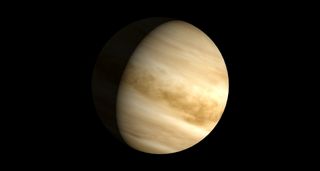
Venus will spend October increasing its angle from the evening sun from 31 to 38 degrees, but the shallow angle of the ecliptic after sunset will keep the brilliant, magnitude -3.95 planet low in the southwestern sky for mid-northern latitude observers. As October begins, the surrounding stars of Libra will begin to appear just as the planet is setting. By the time it crosses into next-door Scorpius on Oct. 17, and then Ophiuchus on Oct. 24, Venus will be setting late enough for those stars to twinkle around it. Watch for Venus shining only a few degrees above the very bright star Antares on the evenings surrounding Oct. 25. Telescope owners and imagers can catch Venus passing very close to Messier 80 on Oct. 22-23 and the Rho Ophiuchi complex on Oct. 23-25. Telescope views of Venus will in October will show a three-quarters illuminated disk that will wane slightly in phase and grow from 12.3 to 14.2 arc-seconds across over the course of the month. On Oct. 5, Venus will shine 4 degrees to the upper right (or celestial north) of the young crescent moon while Libra's lovely double star Zubenelgenubi poses just to Venus' upper right.
Mars
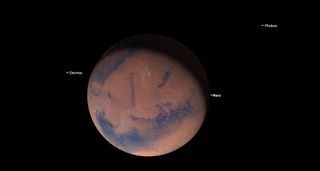
As October begins, mid-northern latitude observers are seeing Mars rising in the east at midnight local time and then climbing to shine high in the southern sky by sunrise, not too far from far brighter Jupiter. Over the month, the red planet will brighten a little from magnitude 0.5 to 0.1 while it travels eastward through the stars of central Gemini. When the planet crosses into Cancer on Oct. 30, it will be rising by 11 p.m. In a telescope, Mars will display an 88%-illuminated, waxing gibbous phase on a ruddy-colored disk that grows in size from 7.6 to 9.1 arc-seconds due to its reducing distance from Earth. On Oct. 16-18, Mars will pass less than a degree north of the Twinkling Comet cluster (NGC 2420). It will be joined in Gemini by the waning gibbous moon on Oct. 22.
Jupiter
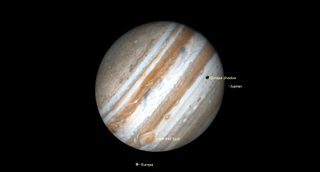
Brilliant, white Jupiter will shine all night long during October, rising at about 10 p.m. on Oct. 1 and by 8 p.m. at month's end. Early risers will see the bright planet shining high in the southwestern sky before sunrise every morning. On Oct. 9, Jupiter will halt its eastward motion and commence a retrograde loop that will carry it west between the horns of Taurus until February. In the interim, the brightest stars of winter will encircle the planet. Visually, Jupiter will fade very slightly from magnitude -2.48 to -2.68 while its disk grows from 42.3 to 46 arc-seconds. Binoculars will reveal Jupiter's four large Galilean moons flanking the planet. A backyard telescope will show its equatorial bands, while a better quality instrument will reveal the Great Red Spot every 2nd or 3rd night, Jupiter's Galilean satellites frequently eclipsing and occulting one another, and times when they cast their round, black shadows on the planet. The waning gibbous moon will shine to the upper left (north) of Jupiter on Oct. 21, setting up some nice photo opportunities.
Saturn
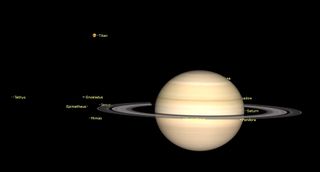
Saturn will be perfectly positioned for evening and late-night viewing during October because the planet will already be climbing in the east as the sky darkens after dusk. Its medium-bright, creamy-yellow dot will continue to travel retrograde westward through the stars of eastern Aquarius - with faint Neptune positioned 14 degrees to its left (or celestial ENE). Viewed in a telescope, Saturn will show an apparent disk diameter of about 18.8 arc-seconds, and its rings will subtend 43.7 arc-seconds. Since Saturn has now passed opposition, the wedge of shadow that its globe casts upon its rings will be growing steadily. Saturn's rings will be tilted by a mere 3 degrees and will become even more edge-on to Earth until the spring of 2025. Saturn's moons will be aligned with the ring plane this year, allowing you to see the transits of them and their tiny black shadows across Saturn's globe — sometimes in pairs — through high-quality telescopes. The waxing gibbous moon will hop past Saturn from Oct. 13 to 14. On Oct. 14 around 05:00 GMT, observers located along a zone extending from southern Africa east across Madagascar, the southeastern Arabian Peninsula, and most of southern Asia, China, and Mongolia can watch the moon occult Saturn
Uranus
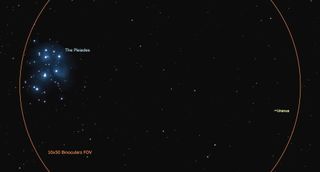
During October, magnitude 5.6 Uranus will be nicely positioned for viewing all night long through binoculars and telescopes of any size. Since it will be reaching opposition on November 17, the planet will rise soon after dusk in October. Uranus will be shifting almost imperceptibly retrograde westward through the stars of western Taurus, a palm's width to the lower right (or 6 degrees to the celestial SSW of) the Pleiades Star cluster. Jupiter will follow it across the sky about 90 minutes behind on the ecliptic. In a telescope, Uranus will display a blue-green, 3.8 arc-seconds-wide disk. The bright, waning gibbous moon will hop past Uranus and the Pleiades on Oct. 18-19.
Neptune

The blue speck of magnitude 7.8 planet Neptune will be available to observe from dusk until the wee hours during October. Recently past opposition, Neptune will be creeping westward about 7 degrees below the circle of stars that forms Pisces' western fish, and about 2 degrees above (or celestial north) of the upright rectangle formed by the medium-bright stars 27, 29, 30, and 33 Piscium. Much brighter Saturn will be shining about 14 degrees to Neptune's right (or celestial west). Viewed in a telescope, Neptune will show a disk size of 2.35 arc-seconds. Larger telescope owners can see its largest moon Triton.
Skywatching terms
Gibbous: Used to describe a planet or moon that is more than 50% illuminated.
Asterism: A noteworthy or striking pattern of stars within a larger constellation.
Degrees (measuring the sky): The sky is 360 degrees all the way around, which means roughly 180 degrees from horizon to horizon. It's easy to measure distances between objects: Your fist on an outstretched arm covers about 10 degrees of sky, while a finger covers about one degree.
Visual Magnitude: This is the astronomer's scale for measuring the brightness of objects in the sky. The dimmest object visible in the night sky under perfectly dark conditions is about magnitude 6.5. Brighter stars are magnitude 2 or 1. The brightest objects get negative numbers. Venus can be as bright as magnitude minus 4.9. The full moon is minus 12.7 and the sun is minus 26.8.
Terminator: The boundary on the moon between sunlight and shadow.
Zenith: The point in the sky directly overhead.
Night sky observing tips
Adjust to the dark: If you wish to observe fainter objects, such as meteors, dim stars, nebulas, and galaxies, give your eyes at least 15 minutes to adjust to the darkness. Avoid looking at your phone's bright screen by keeping it tucked away. If you must use it, set the brightness to minimum — or cover it with clingy red film.
Light Pollution: Even from a big city, one can see the moon, a handful of bright stars, and the brightest planets - if they are above the horizon. But to fully enjoy the heavens — especially a meteor shower, the fainter constellations, or to see the amazing swath across the sky that is the disk of our home galaxy, the Milky Way — rural areas are best for night sky viewing. If you're stuck in a city or suburban area, use a tree or dark building to block ambient light (or moonlight) and help reveal fainter sky objects. If you're in the suburbs, simply turning off outdoor lights can help.
Prepare for skywatching: If you plan to be outside for more than a few minutes, and it's not a warm summer evening, dress more warmly than you think is necessary. An hour of winter observing can chill you to the bone. For meteor showers, a blanket or lounge chair will prove to be much more comfortable than standing, or sitting in a chair and craning your neck to see overhead.
Daytime skywatching: On the days surrounding first quarter, the moon is visible in the afternoon daytime sky. At last quarter, the moon rises before sunrise and lingers into the morning daytime sky. When Venus is at a significant angle away from the sun it can often be spotted during the day as a brilliant point of light - but you'll need to consult an astronomy app to know when and where to look for it. When large sunspots develop on the sun, they can be seen without a telescope — as long as you use proper solar filters, such as eclipse glasses. Permanent eye damage can occur if you look at the sun for any length of time without protective eyewear.
Join our Space Forums to keep talking space on the latest missions, night sky and more! And if you have a news tip, correction or comment, let us know at: community@space.com.
Get the Space.com Newsletter
Breaking space news, the latest updates on rocket launches, skywatching events and more!
Chris Vaughan, aka @astrogeoguy, is an award-winning astronomer and Earth scientist with Astrogeo.ca, based near Toronto, Canada. He is a member of the Royal Astronomical Society of Canada and hosts their Insider's Guide to the Galaxy webcasts on YouTube. An avid visual astronomer, Chris operates the historic 74˝ telescope at the David Dunlap Observatory. He frequently organizes local star parties and solar astronomy sessions, and regularly delivers presentations about astronomy and Earth and planetary science, to students and the public in his Digital Starlab portable planetarium. His weekly Astronomy Skylights blog at www.AstroGeo.ca is enjoyed by readers worldwide. He is a regular contributor to SkyNews magazine, writes the monthly Night Sky Calendar for Space.com in cooperation with Simulation Curriculum, the creators of Starry Night and SkySafari, and content for several popular astronomy apps. His book "110 Things to See with a Telescope", was released in 2021.
-
Malcolm Hi MMohammad,Reply
Thank you for your gracious welcome via email, though I fear we are ‘light years’ away from each other (as my comment shows, if it stays and is not censored) when it comes to this Earth and the Universe in which we live. I am no expert but each to their own beliefs.
Regards,
Malcolm -
Skyguy712 Reply
so much cap like if they don't exist then it's all most impossible for the universe to exist, i have a theory of the big bang, the white hole theory, i believe that a black hole had held gas and dust for millions of years and then it got older and older that it had died and spit up the dust and matter and gas and such, then it all collided making planets and suchcorey555 said:Black holes don't exist
